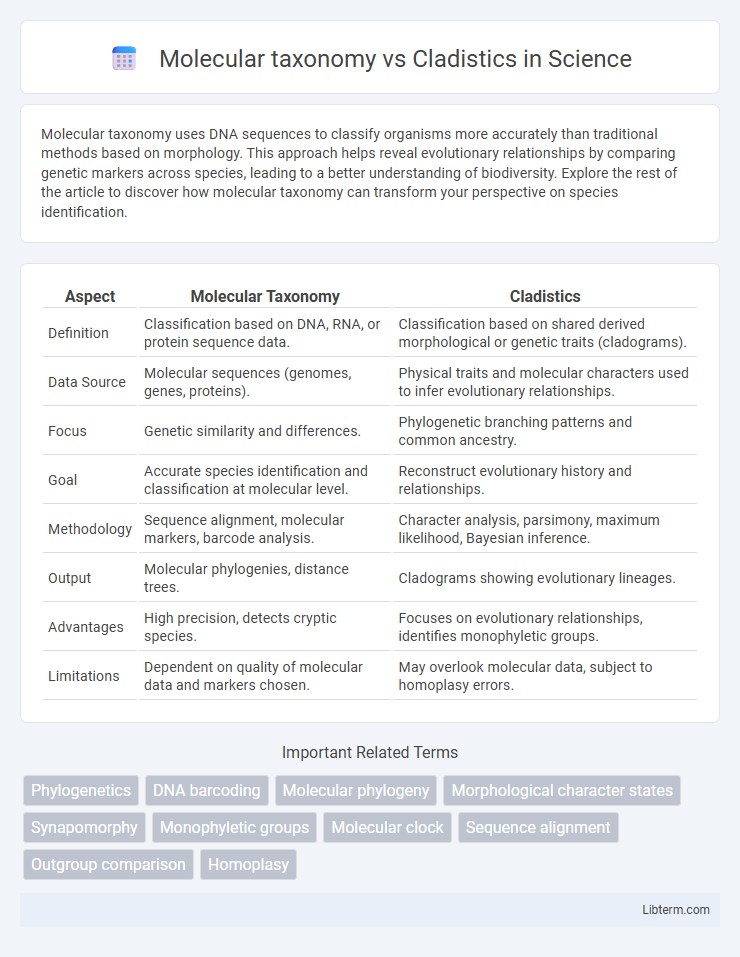Molecular taxonomy uses DNA sequences to classify organisms more accurately than traditional methods based on morphology. This approach helps reveal evolutionary relationships by comparing genetic markers across species, leading to a better understanding of biodiversity. Explore the rest of the article to discover how molecular taxonomy can transform your perspective on species identification.
Table of Comparison
| Aspect | Molecular Taxonomy | Cladistics |
|---|---|---|
| Definition | Classification based on DNA, RNA, or protein sequence data. | Classification based on shared derived morphological or genetic traits (cladograms). |
| Data Source | Molecular sequences (genomes, genes, proteins). | Physical traits and molecular characters used to infer evolutionary relationships. |
| Focus | Genetic similarity and differences. | Phylogenetic branching patterns and common ancestry. |
| Goal | Accurate species identification and classification at molecular level. | Reconstruct evolutionary history and relationships. |
| Methodology | Sequence alignment, molecular markers, barcode analysis. | Character analysis, parsimony, maximum likelihood, Bayesian inference. |
| Output | Molecular phylogenies, distance trees. | Cladograms showing evolutionary lineages. |
| Advantages | High precision, detects cryptic species. | Focuses on evolutionary relationships, identifies monophyletic groups. |
| Limitations | Dependent on quality of molecular data and markers chosen. | May overlook molecular data, subject to homoplasy errors. |
Introduction to Molecular Taxonomy and Cladistics
Molecular taxonomy utilizes DNA, RNA, or protein sequence data to classify organisms based on genetic similarities and evolutionary relationships, enabling accurate identification at the molecular level. Cladistics, in contrast, focuses on analyzing shared derived characteristics (synapomorphies) to construct phylogenetic trees that reflect evolutionary lineage branching patterns. Both methods contribute to systematics, with molecular taxonomy offering detailed genetic insights while cladistics provides a framework for evolutionary history based on character states.
Historical Overview of Classification Systems
Molecular taxonomy revolutionized classification by utilizing DNA, RNA, and protein sequences to determine evolutionary relationships, contrasting with early cladistics that relied primarily on morphological characteristics and shared derived traits (synapomorphies). The advent of molecular techniques in the late 20th century provided more precise phylogenetic trees compared to classical cladistic methods established by Willi Hennig in the 1950s. This shift enhanced the accuracy of evolutionary biology by integrating genetic data into the hierarchical classification systems historically based on physical traits.
Core Principles of Molecular Taxonomy
Molecular taxonomy relies on analyzing DNA, RNA, or protein sequences to classify organisms based on genetic similarity and evolutionary relationships, emphasizing molecular markers such as mitochondrial DNA and ribosomal RNA genes. Core principles include the use of molecular data to infer phylogenetic trees, genetic distance measurements, and the identification of homologous sequences to determine taxonomic hierarchy. Unlike cladistics, which primarily uses morphological traits and shared derived characteristics (synapomorphies), molecular taxonomy provides a more quantifiable and objective framework for resolving evolutionary relationships at various taxonomic levels.
Fundamental Concepts of Cladistics
Cladistics fundamentally classifies organisms based on shared derived characteristics called synapomorphies, which indicate common ancestry and evolutionary relationships. Unlike molecular taxonomy that relies primarily on genetic sequences, cladistics emphasizes the reconstruction of phylogenetic trees through the analysis of morphological or molecular traits to infer evolutionary branching patterns. The principle of parsimony is central to cladistics, aiming to identify the simplest tree with the fewest evolutionary changes.
Methodologies: DNA Sequencing vs Morphological Analysis
Molecular taxonomy employs DNA sequencing techniques to analyze genetic material, providing precise insights into evolutionary relationships by comparing nucleotide sequences across species. Cladistics relies on morphological analysis, focusing on shared physical traits and their variations to construct phylogenetic trees based on common ancestry. DNA sequencing offers higher resolution in detecting genetic divergence, while morphological analysis emphasizes observable characteristics that may be influenced by environmental adaptation.
Comparative Strengths and Limitations
Molecular taxonomy offers high-resolution insights into genetic relationships by analyzing DNA sequences, enabling precise species identification and evolutionary inference, but it can be limited by horizontal gene transfer and incomplete lineage sorting. Cladistics constructs phylogenies based on shared derived morphological traits, providing a clear framework for hypothesizing evolutionary relationships, though it may be constrained by homoplasy and morphological convergence. Combining molecular data with cladistic analysis enhances robustness in phylogenetic reconstructions by balancing genetic evidence with observable character states.
Case Studies: Applications in Modern Biology
Molecular taxonomy leverages DNA sequencing to classify organisms based on genetic similarity, as seen in case studies like the identification of cryptic species in frogs through mitochondrial DNA analysis. Cladistics employs shared derived characteristics to infer evolutionary relationships, exemplified by studies reconstructing dinosaur phylogeny using morphological traits. These approaches complement each other in modern biology, enhancing species delineation and evolutionary history reconstruction in diverse taxa.
Controversies and Debates in Systematics
Molecular taxonomy faces debates regarding the reliability of genetic markers and horizontal gene transfer impacting phylogenetic accuracy, contrasting with cladistics' reliance on morphological traits which can be influenced by convergent evolution. Critics argue that exclusive molecular data may overlook functional adaptations, while proponents claim it provides more objective lineage relationships. Disputes persist over integrating molecular and morphological data, reflecting broader controversies in reconstructing evolutionary histories within systematics.
Integration of Molecular Data in Cladistic Analysis
Integration of molecular data in cladistic analysis enhances the resolution and accuracy of phylogenetic trees by providing genetic markers such as mitochondrial DNA sequences and nuclear genes. Molecular taxonomy leverages DNA barcoding and genome sequencing to identify species boundaries, while cladistics uses shared derived characters to infer evolutionary relationships, enabling a comprehensive synthesis of genetic and morphological data. This convergence allows systematic biologists to reconstruct more robust evolutionary histories and resolve taxonomic ambiguities, especially in cryptic species complexes.
Future Perspectives in Taxonomy and Phylogenetics
Molecular taxonomy leverages genetic sequencing technologies to provide precise species identification and evolutionary relationships, enhancing taxonomic resolution beyond morphological traits. Cladistics employs shared derived characteristics to reconstruct phylogenetic trees, focusing on common ancestry and evolutionary pathways. Future perspectives in taxonomy and phylogenetics emphasize integrating high-throughput genomic data and advanced computational tools, enabling more accurate, comprehensive, and dynamic classification systems that reflect evolutionary history with unprecedented depth.
Molecular taxonomy Infographic

 libterm.com
libterm.com